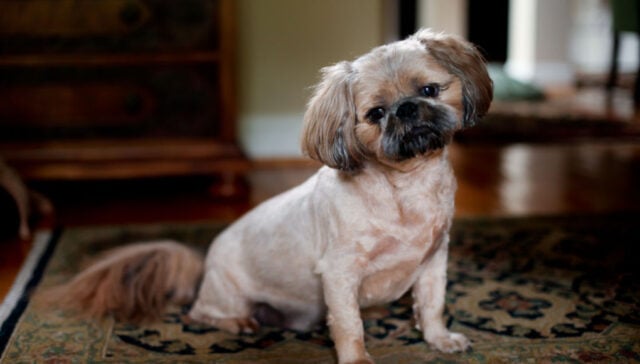
A Pugapoo breed might be what you’re looking for if you want the best of both worlds.
You can combine the intelligent Pug and the adorable Poodle into one furry pet, avoiding the need to choose between them.
A Pugapoo is a gorgeous mix of breeds between a Pug and a Poodle.
This unmistakably endearing pug-poodle mix is a family-loving, eager, trainable companion at its best.
This breed may be a suitable fit for you if you have a semi-active lifestyle because of its average activity level.
Its idea of fun is limited to two options: a limited amount of time to play fetch in your yard or lounging on your lap.
Without further ado, let's get started and discover everything there is to know about this beautiful mixed breed!
Pugapoo Dog Breed History
The Pugapoo (poo-ga-poo) is a mixed-breed dog. It is a cross between the Pug and the Poodle.
The name is a portmanteau of the words Pug and Poo. It also goes by the names Pug-A-Poo, Pugadoodle, Pugoodle, or just Pugpoo.
This pug-poodle mix has grown in popularity in the last twenty years. However, its exact origins are unknown.
To understand Pugapoo's history, we must start with its parent breeds.
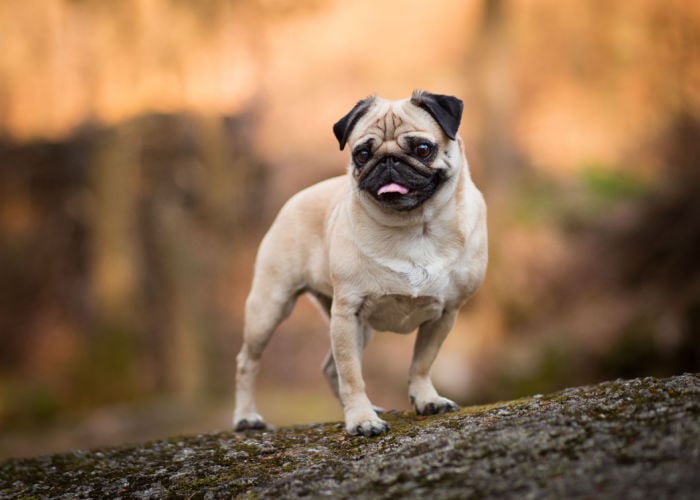
The Pug
Pugs are an ancient breed of dog that was primarily bred in China. Some scholars believe they are related to the Tibetan Mastiff.
Nobles adored the Pug for most of its existence.
They were kept as companion animals for Chinese emperors who pampered and supplied them with luxurious quarters.
As trade between China and Europe expanded in the 16th century, the Pug found new nations that adored them.
They quickly gained favor with the aristocracy, particularly the Dutch Royal family.
One legendary dog even saved William, Prince of Orange, by barking a warning when a military camp came under a surprise attack.
Later, when the prince assumed the throne as King William III of England, he traveled with his Pugs and introduced the marvelous breed to a new nation.
Following the Civil War, the Pug arrived in the United States, and the American Kennel Club recorded the first Pug in 1885.
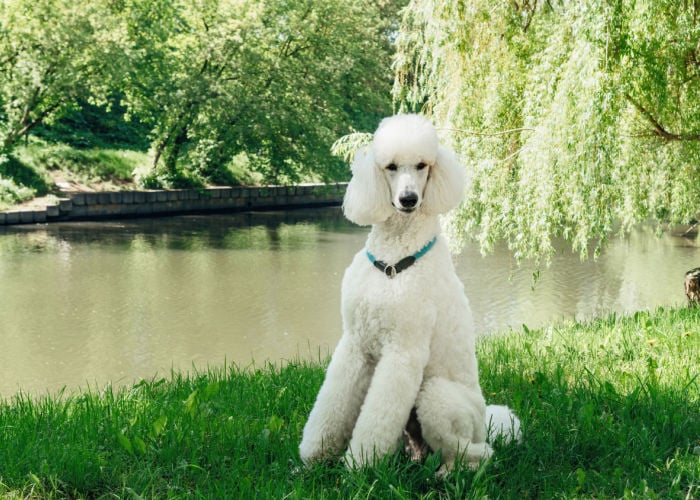
The Poodle
The Poodle's history dates back to the 15th century in Germany, when it was first bred as a water dog.
The name derives from the word “pudel,” which means to splash around in water in German.
This name accurately captures their beginnings as German duck-hunting dogs.
But the Poodle as we know it today originated in France, where it was crossed with numerous other European dogs.
These dogs were large, similar to the modern-day Poodle.
With the growing popularity of this breed, miniature and toy Poodles began to emerge.
They carved out a special place for themselves as canine companions, ensuring that every home had a Poodle dog.
Pugapoo Appearance
Pugapoos have a medium-sized nose, droopy ears, a thin build, and a curly or straight coat with a mix of black, white, and brown fur.
A slender Pug and an athletic Poodle have distinct physiques, and the Pugapoo exhibits this.
Taking the middle ground, Pugapoos are likely to be tiny in stature, with a fair length of leg and a slim to stocky physique.
Their tail is an intriguing characteristic, which can be a traditional Pug corkscrew tail that sits on their rear or the straight, whippy wag of the Poodle.
They come in various sizes, from around 10 pounds to as much as 30 pounds, depending on the size of the dominant parent.
Pugapoo Temperament
Pugapoos are friendly, affectionate, and delightful dogs at their best—just like their parents, the Pug and the Poodle.
The Poodle might have more “smarts” than the Pug, but the Pug makes up for it with an extra dose of cuteness.
No wonder the Pugapoo dog is not only adorable but also highly intelligent!
In that case, you might wish to invest in the right dog toys that not only provide physical stimulation for your Pugapoo but also stimulate its mind.
Be aware that the pug-poodle mix is prone to trouble if you’re not giving them attention.
Your Pugapoo may inherit some stubbornness from its Pug parent.
Insufficient stimulation may cause these dogs to try to entertain themselves. This may result in destructive chewing and digging.
In addition, this breed can be a barker if the Poodle side is dominant. Therefore, you should prepare to train your dog to stop barking on command.
The good news is that this mix has no specific space needs.
If you live in a rental unit or an apartment, there's no need to worry as it can adapt to different living situations.
Fortunately, the Pugadoodle likes to get along with just about everyone!
Pugapoo Puppies
Pugapoo puppies can either be first-generation or multi-generation crossbred.
If both parents are purebred dogs, the Pugadoodle is a first-generation pup; otherwise, it is a second-generation pup.
However, the characteristics of Pugapoo puppies from the same litter might differ greatly from one another.
For best results, always get your pups from an established breeder who does health screenings.
Additionally, it's an excellent choice to socialize and teach your Pugapoo puppy as soon as possible to ensure it grows with positive behavior.
Grooming a Pugapoo
Depending on the coat type, your Pugapoo will have different grooming requirements.
Although the long, curly Poodle coat sheds very little, you must groom your pooch every four to six weeks.
Bathing it once every three to six weeks is also important.
On the other hand, the short Pug coat sheds more but only requires weekly brushing to remove dead hair.
Bathe Fido once every four weeks or until it gets dirty.
In addition, you must keep your dog’s ears clean and dry. It’s best to clean them daily with a cleaning solution advised by your vet.
The rest is simple basic care.
Trim its nails once every two to three weeks.
Also, don't forget to brush your dog's teeth daily with dog-specific toothpaste for optimum health.
Without proper dental care, your Pugapoo is susceptible to bleeding gums and misaligned teeth.
Pugapoo Trainability
Due to their intellect, trainability, and athleticism, poodles have historically been used as circus dogs.
The Pug, on the other hand, tends to be fairly stubborn and set in their ways.
Merge the two for producing a Pugadoodle; a fur parent must be consistent and patient with training.
Keep things light and encourage your dog to make it successful.
Pugs are highly driven by food, so using reward-based training techniques that include treats is a surefire way to get your Pugapoo to cooperate.
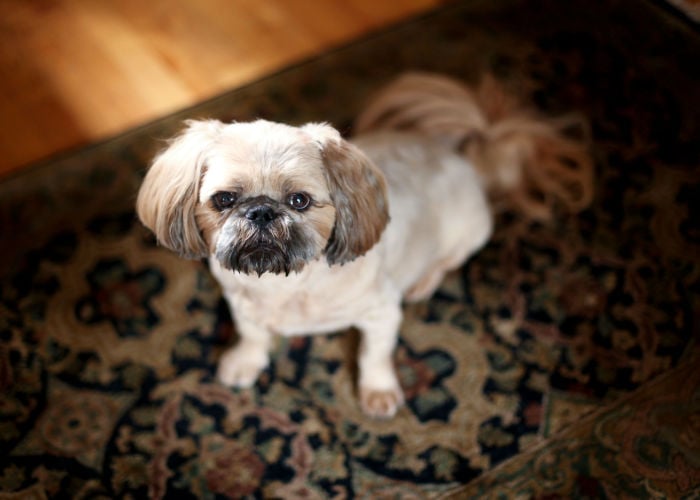
Pugapoo Exercise and Activity Levels
Many dog enthusiasts are misled into believing high-energy dogs, like Pugadoddle, require much outdoor time and exercise.
However, you must take your Pugapoo dog's size into mind.
This breed only needs one hour of exercise per day.
Your miniature pooch is not suited to daily long walks to the park, endless rounds of fetch in the heat, or a lot of running.
The pug-poodle mix is a house dog that enjoys spending hours curled up on the couch or in the lap of a loved family member.
However, in an effort to control their weight, a quick stroll and indoor activities like tug of war and a few trips up and down the stairs will stop Fido from going into hyper mode.
Pugapoo Diet
Make sure to feed this cute little dog a balanced diet.
Regular meals for this breed should consist of high-quality foods designed for dogs of their size and energy level.
A full-grown Pugapoo tends to gain weight, which could increase their risk of getting diabetes.
Therefore, if your beloved companion is gaining weight, it's a good idea to limit the amount of food.
The recommended serving size may vary significantly depending on the dog's age, natural size, and degree of activity.
Ask your vet for advice on your dog's nutrition just to be safe.
Pugapoo Lifespan
The typical lifespan of your Pugapoo is 12 to 14 years. Life expectancy is only a basic benchmark, though.
To guarantee that your furry friend has a long and healthy life, giving it the best attention and treatment is crucial.
This includes closely monitoring diet and physical activity as well as keeping an eye out for potential health risks.
All of this will be covered in greater detail in the following section.
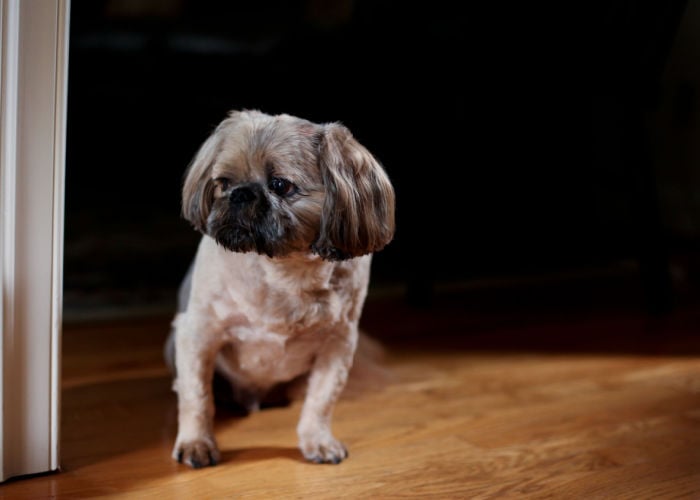
Pugapoo Health Issues
Due to the hybrid nature of the Pugapoo breed, limited statistical information is available on its specific health issues.
However, some Pugapoo puppies may have specific diseases which are common in the parent breeds.
Cancer
For Pugs, cancer is the most common cause of death.
A 2006 study published in Veterinary and Comparative Oncology found that 56% of Pugs had MCTs.
Skin cancers known as mast cell tumors (MCTs) are frequent in middle-aged to older dogs.
These are known to be brought on by environmental and genetic factors.
The most typical symptom is a red or swollen lump that seems to grow or shrink at irregular intervals.
Unfortunately, the lump is the only observable sign.
Sometimes though, your dog's stomach can develop ulcers.
You might then notice dark stool, vomiting, loss of appetite, or fatigue.
Allergies
Pugs are susceptible to a range of dog allergies, including food-related (typically an allergic response to ingredients) and airborne (grasses and pollen).
Atopic dermatitis, or atopy for short, is the most typical type of dog allergy.
It’s an inflammatory chronic skin ailment resulting from your dog's immune system overreacting to an allergen.
How can you tell if your dog has allergies and what to check for?
Symptoms include:
- Rash
- Hives
- Sneezing
- Hot spots
- Wheezing
- Loss of fur
- Watery eyes
- Excessive licking
Making adjustments to Fido's environment and using over-the-counter allergy medication, such as anti-rich topical sprays, will help minimize its allergies.
Cataracts
When your dog has a cataract, the lens of its eye grows cloudy and loses transparency.
This is a problem with the Poodle breed, especially the miniature varieties.
If the whole lens becomes cloudy, it results in vision distortion and may lead to blindness.
Although a cataract is not painful, your dog may become confused and fearful as a result of visual loss and eventual blindness.
PetMD says you should pay attention if your dog exhibits any of these signs,
- Squinting
- Bumping into things
- Scratching at their eyes
- The middle of the pupil has a white spot
Hip Dysplasia
Simply said, hip dysplasia in dogs is the displacement of a bone from its normal location.
You'll notice a difference in Fido's walk and movement in that regard.
One or more of the following symptoms will be present:
- Narrow stance
- Mobility issues
- Signs of discomfort
- Loss of muscle tone
- Lameness in hind legs
For prevention, maintain a healthy weight for your dog since extra joint strain worsens problems.
Furthermore, discourage any action that requires jumping from a height that is too great.
For instance, letting your canine friend jump off huge stones in the yard or off of beds and other pieces of furniture.
Patellar Luxation
There is evidence that one of the most prevalent orthopedic problems in petite breed dogs, like Poodles, is patellar luxation.
But what is it?
The layman's term for patella is the kneecap, while “luxation” means out of place or dislocated.
The combination of the two terms generally means that your dog has a dislocated kneecap.
Your four-legged friend is not in danger of dying, but this could affect how it lives.
Therefore, it's important to control Fido's weight and keep its exercise routine simple.
Usually, this can stop the patella from incurring more harm.
Additionally, joint supplements like glucosamine and chondroitin can help keep your dog's joints healthy.
Diabetes Mellitus
A hormonal condition known as diabetes mellitus develops when blood sugar levels are not properly controlled.
There is evidence that the condition may have a genetic basis.
Poodles are at higher risk of developing DM than the general canine population.
This condition causes your dog to lose weight, have a bad coat, and possibly exhibit increased hunger and lethargy.
Over time, your furry friend may experience injury to its small blood vessels and nerves, resulting in cataracts in the eye.
Cushing’s Disease
Cushing's disease occurs when the body produces an excessive amount of the hormone cortisol.
Ann Stohlman, a vet at FDA's Center for Veterinary Medicine, says cortisol is one of the body’s natural steroids.
It aids in the regulation of healthy body weight, skin condition, tissue structure, and other aspects of good health.
However, excess cortisol impairs Fido's immune system, making him prone to other diseases and infections.
The disease progresses slowly, and you might overlook the early warning signals. The symptoms include:
- Hair loss
- Increased thirst
- Increased appetite
- Thin or fragile skin
- Increased urination
- Recurrent skin infections
Addison’s Disease
Approximately 8% to 10% of Standard Poodle dogs have Addison's disease.
This happens when the hormones that the adrenal glands are responsible for making in the body aren't produced.
These glands primarily produce aldosterone and cortisol, which are essential hormones.
These steroids aid in the regulation of your dog's internal organs and bodily functions.
Without them, Fido's body deteriorates, which might cause significant problems or even death.
Unfortunately, the AKC reports that there is no known cure for this illness.
That means our canine companions will require these replacement hormones for the rest of their lives.
Pug Dog Encephalitis
According to the UC Davis School of Veterinary Medicine, approximately 1.4% of Pug dogs die of PDE.
Unfortunately, it’s a deadly inflammatory illness of the central nervous system.
PDE can also occur in dogs of other breeds, including Chihuahuas and Yorkshire terriers.
Medium- and large-breed dogs have not yet been reported to have the condition.
Many cases begin with vague symptoms, which are frequently disregarded, like lethargy and depression.
Dog parents may observe progressively severe symptoms as the condition worsens, including:
- Circling
- Seizures
- Collapse
- Blindness
- Abnormal gait
- Behavior changes
- Weakness, stumbling
- Appearing lost or disoriented
Younger female fawn-colored Pugs are more likely to develop PDE than older male non-fawn-colored Pugs.
Gastric Dilation Volvulus
It is referred to as either killer bloat or bloat. This abdominal swelling is dangerous and might even be fatal.
Gastric volvulus in dogs occurs when the stomach twists
Your dog experiences shock as a result of the spleen's critical blood supply being cut off by the enlargement and twisting.
Sadly, this will be extremely painful for Fido.
According to VCA Animal Hospitals, the following factors can reduce the likelihood of bloat:
- Eating two or more meals per day
- Adding canned dog food to the diet
- Having a relaxed, contented, or easy-going temperament
- Feeding a dry food containing a calcium-rich meat meal (such as fish, meat/lamb, chicken by-product meal)
Important: GDV is a serious emergency that requires rapid veterinary attention.
Von Willebrand’s Disease
This is a hereditary bleeding condition brought on by a deficiency in the protein von Willebrand factor (vQF).
This protein is crucial for the development of clots. Without it, an injury to your four-legged friend may result in severe bleeding.
For dogs with vWD, this protein may be decreased, dysfunctional, or completely absent.
If you plan to breed your dog, testing is crucial. Fido's safety may be of concern because bleeding may constitute a birthing process complication.
Additionally, because this illness is genetic, it will likely be passed on to offspring.
Note: The majority of experts advise against breeding dogs with the vWD gene.
Legg-Calve-Perthes Disease
This disease causes your pawed friend to limp on the affected leg.
It is unclear what specifically causes this disease.
According to studies, the hip's blood flow may be compromised, and this disturbance may result from blood vessel clots.
Small fractures develop as the bone starts to deteriorate and weaken.
Over time, scar tissue may form to help the bone stay in place. However, arthritis will result from changes in the bone's structure.
According to Cornell University, small dog breeds are most commonly affected with Legg-Calve-Perthes disease, which manifests in puppies as young as six months old.
Progressive Retinal Atrophy
PRA is a genetic condition that causes blindness in dogs.
Canines with PRA may at first display symptoms of night blindness.
Your canine companion can be reluctant to venture outside at night. Also, you’ll notice a more green or yellow reflection from its eyes when it's dark.
Generally speaking, PRA can affect both purebred and mixed-breed dogs.
This condition is not painful, so it is rarely recognized in the early stages of progression.
The initial signs of Fido's PRA are often as follows:
- Night blindness
- Tends to be nervous at night
- Reluctant to go into dark rooms
- The pupils are more dilated than usual
- May bump into things when the light is dim
- Eyes have become reflective when light shines on them
Pugapoo Dog Breed: FAQs
Do Pugapoos bark a lot?
Pugs aren't known to bark as much as Poodles do. It depends on whose parent is dominant.
Therefore, if your Pug-A-Poo is a barker, make sure to train it to stop on command.
And to do that, keep your training sessions positive and upbeat.
Do Pugapoos shed hair?
Pugapoos shed hair when they inherit the coat of their Pug parent.
Pugs shed more in the fall and spring as their coat adjusts to more abrasive temperatures.
The best brush for your Pug-A-Poo is either a soft bristle or rubber curry brush.
Additionally, you'll need a flea comb, wipes, conditioner, and shampoo that's suitable for dogs.
Can Pugapoos stand the cold?
Pugs do get cold in winter, and the same holds true for Poodles. So, you shouldn't leave your dog outdoors in the cold for too long.
Your pug-poodle mix could suffer from cold-related health issues, including hypothermia or frostbite, regardless of whether it has the long coat of its Poodle parent or the short coat of its Pug parent.
Pugapoo Dog Breed: Is This the Right Breed For You?
Pugapoos are undoubtedly among the cutest and smartest dog breeds out there.
This Pug and Poodle mix beauty excels with children and human households.
This breed is suited for your lifestyle due to its low to moderate level of energy. But since it frequently seeks out company, be sure that you give it proper attention.
They might activate their stubborn side and go around chewing and digging if they have nothing else to do. If they take after the Poodle side, they can be barkers too.
It can be difficult to predict how your pug-poodle mix will develop as a puppy, so time alone will tell how it will look as an adult.
But we guarantee that either way, this affectionate and amiable furball is going to be the happy pill you need!












